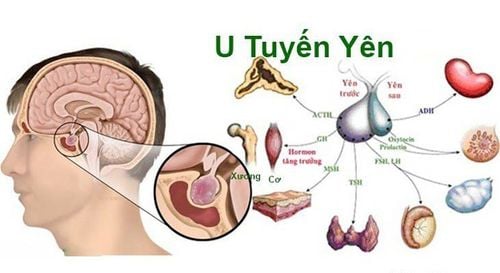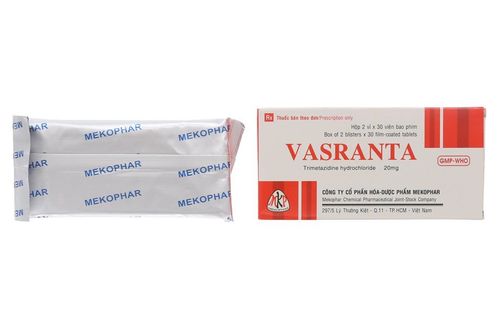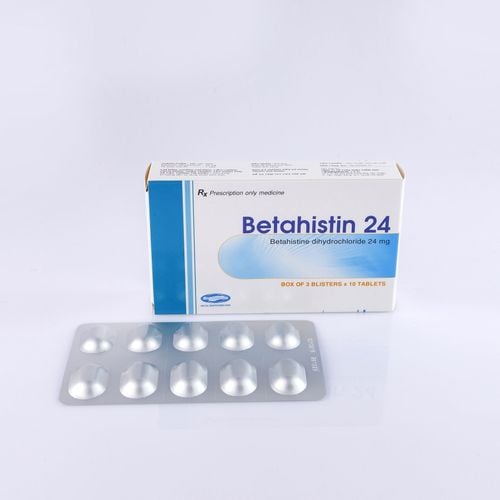This is an automatically translated article.
Neotazine is indicated when the patient cannot control angina or other treatments do not work. Read on to know what Neotazine is, its uses and how to use it safely.
1. What disease does Neotazine treat?
Neotazine belongs to the group of anti-anginal drugs, the main ingredient is Trimetazidine 35mg. Active ingredient Trimetazidine has the effect of increasing the coronary response to exercise after 15 days of treatment, reducing sudden changes in blood pressure during exercise but without changing heart rate.
Neotazine is prepared in the form of film-coated tablets, pink orange in color and indicated for use as an adjunctive or adjunctive therapy in the treatment of symptoms of uncontrollable angina. controllable. In addition, Neotazine is also used for the adjunctive treatment of tinnitus, dizziness, visual disturbances and visual impairment but of circulatory origin.
2. How to use and dose Neotazine
Neotazine is taken orally with meals. The drug is only used in adults with a common dose of 1 tablet / time, 2 times / day. However, the dosage should be noted for the following groups of subjects:
People with moderate renal impairment (with creatinine clearance from 30 - 60ml/min): 1 Neotazine tablet/day, the drug should be taken in the morning. . Elderly people: 1 Neotazine tablet/day, should take the drug in the morning. Because renal function in the elderly often declines with age, the dosage is similar to that of patients with moderate renal impairment.
3. Neotazine side effects
Neotazine can cause some unwanted side effects with the following frequency:
Common: Headache, dizziness, abdominal pain, nausea, vomiting, indigestion, diarrhea, itching, rash, urticaria, body weakness. Rare: Palpitations, tachycardia, palpitations, arterial hypotension and standing, dizziness, fall, flushed face. Frequency not known: Tremor, dyskinesia or slowness, increased muscle tone (symptoms of Parkinson's disease); Restless legs syndrome ; unsteadiness, dyskinesia, lethargy, insomnia, constipation, angioedema, systemic pustular rash (acute), hepatitis, thrombocytopenia, agranulocytosis. When seeing any unusual symptoms after taking Neotazine, the patient should stop and contact a doctor or medical facility for advice.
4. Some notes when using Neotazine
Neotazine should not be used in the following subjects:
People who are allergic or sensitive to the ingredients of the drug; People with restless legs syndrome, Parkinson's disease or other movement disorders; Patients with severe renal impairment (creatinine clearance less than 30ml/min). People with glucose-galactose malabsorption or lapp lactase deficiency should not take the drug because Neotazine contains lactose. Pregnant women are also not allowed to use Neotazine or if you are using it, you should notify your doctor for consideration; For women who are breastfeeding, research information is limited, so it is not recommended to use. In patients being treated with antihypertensive drugs, caution should be exercised when using Neotazine because the drug can cause hypotension, unsteadiness, and falls.
Patients with moderate renal impairment or the elderly (>75 years old) need to use the drug with caution.
When using Neotazine, it is necessary to limit driving and operating machinery because the drug can cause side effects such as dizziness and drowsiness.
Neotazine may interact with MAOIs. The use of Neotazine with any drug should be carefully monitored because drug interaction information is limited. In summary, Neotazine is used for the treatment of angina pectoris as adjunctive therapy in uncontrolled patients or as adjunctive therapy in patients unresponsive to other therapies. Patients need to use the drug exactly as prescribed by the doctor to increase the effectiveness of treatment and ensure safety for health.
Please dial HOTLINE for more information or register for an appointment HERE. Download MyVinmec app to make appointments faster and to manage your bookings easily.













